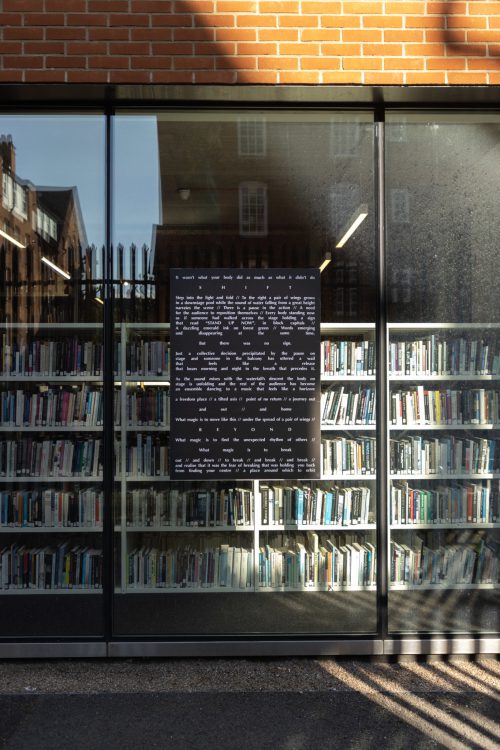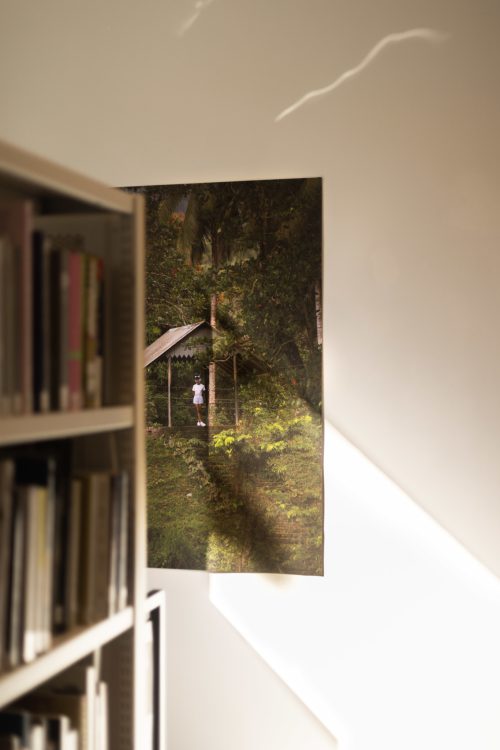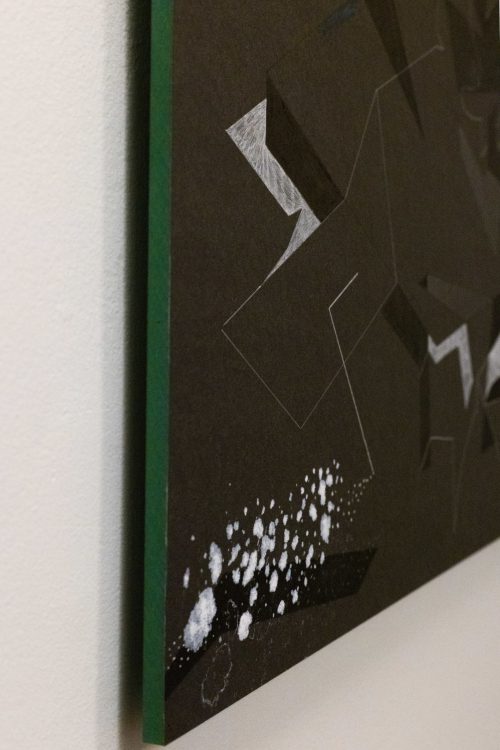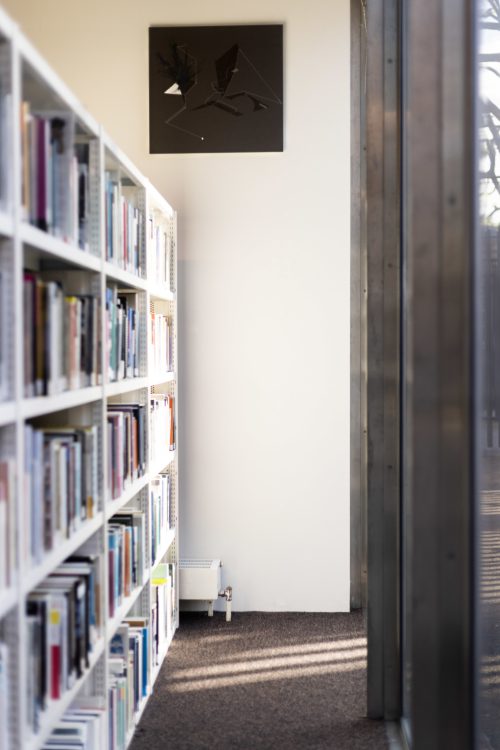
Dancing In The Ellipsis // A Cartographer’s Black Hole, Poem on glass exterior of library, Rohan Ayinde, 2022 Photo credit: Fikayo Adebajo
As part of the Stuart Hall Library Artist-in-Residence 2021, Curatorial Trainee Tobi Alexandra Falade conducted a short interview with Rohan Ayinde to discuss his exhibition, Dancing In The Ellipsis // A Cartographer’s Black Hole.
TAF: During your residency in 2021 how did you use the resources of the Stuart Hall Library to shape your research?
RA: I started by searching the Stuart Hall Library catalogue online using key words to find texts that were related to my research. There were a few points that I was starting from such as abstraction, and I was also looking at Frank Bowling and Aubrey Williams as artists related to abstraction. These were my three starting points alongside reading Stuart Hall’s essay on diaspora identity. I pored through the books I found, sat with them reading sections and making copious notes that were both related to the books, and to the research I had already developed, thinking about where that led me as a portal for new ideas that weren’t specifically about abstraction.
TAF: How does your exhibition explore Stuart Hall’s description of “diaspora identity”?
RA: My understanding of Stuart Hall’s description of diaspora identity is this idea that people from diaspora are in a constant state of becoming. There is no stable marker of identity other than in the idea of movement, and the process of translation from one thing to another. Whilst there are maybe a set cultural grounds that we emerge from, diaspora represents the transformations we have been through.

“Before: Knowing/ language/ movement/ home” Photograph by Rohan Ayinde, 2022 Photo credit: Fikayo Adebajo
Dancing In The Ellipsis // A Cartographer’s Black Hole explores these ideas through thinking about diaspora identity as an expression of what blackness is generally, but more specifically what my blackness is as I grapple with the uncertainty or the instability of an identity that I wear with such pride.
I also think of this in terms of ‘home’. Home can be Jamaica, even though I’m not from Jamaica, it could be Guyana where my people are from, but maybe home is Nigeria because my name is Yoruba. And at the same time home is all of the places that we have moved as a people.
The drawings do a similar thing of trying to work their way through the multiplicity of what that expression of blackness is, which can’t be mapped in the way that we may think of maps as fixed markers of place. There’s a great deal of movement in between those points, like an anti-map, and in that way maybe I read Stuart Hall’s description of a diaspora identity as an anti-identity.
TAF: Was there something new or surprising you found out about your artwork, practice or your research through Dancing In The Ellipsis // A Cartographer’s Black Hole?

“Gestures toward the impossibility of belonging” Drawing by Rohan Ayinde, 2022
Photo credit: Fikayo Adebajo
RA: I found a connection to myself, to my own body in my work. That was new and surprising and maybe something that I’ve been searching for. So many of my thoughts around my research have been grappling with large ideas that are about abstract blackness, black holes or radical politics and those are really important things to grapple with but they can feel like, where do I live within them? Where am I anchored as a self within this research? I found my centre as a result of the residency. That has been a revelation for me because it’s like, okay, my body holds these larger questions, so I need to look inward rather than trying to find them as these kinds of floating signifiers outside of myself.
But that would not have been possible without long conversations with Assistant Librarian Sae Matsuno, and conversations with curators Tobi Alexandra Falade and Beatriz Lobo about the work as it developed, or check ins with Artistic Director Sepake Angiama. It also wouldn’t have been possible without the books, both through reading but also because the words were leaking out of the shelves and interacting with my energy to generate something new.
TAF: What do you hope to gain from sharing your artworks and your research, with iniva’s audiences, Stuart Hall Library users, and the Research Network?
RA: I think, ultimately my work is about collaboration in one way or another. And the research taught me that it is always a collaborative process, whether that be about the conversations or whether it be about the books that I’m taking in and then translating through the work. And so, I think of the people who engage with the work, the people who have gone into the making of the work as collaborators. Sae said this interesting thing to me yesterday about being with the work, and how it gives her a place to meditate. In some ways it’s what I hoped to do, to make work that listens to its audiences, and so I hope to gain something from the space of listening that the work opens up.

“How thinking through movement can alter the force of thought” Drawing by Rohan Ayinde, 2022
Photo credit: Fikayo Adebajo
I imagine each iteration of work that I share as allowing me to develop the work and my practice forever because it moves forward as a result of the way that you hear people are engaging with it. The questions and critiques they have, what they liked, what they didn’t like. It becomes the continuing journey of my practice.
TAF: Where can readers find out more about your work?
RA:
https://www.instagram.com/rohanayinde/
https://twitter.com/the_ras_poet/
